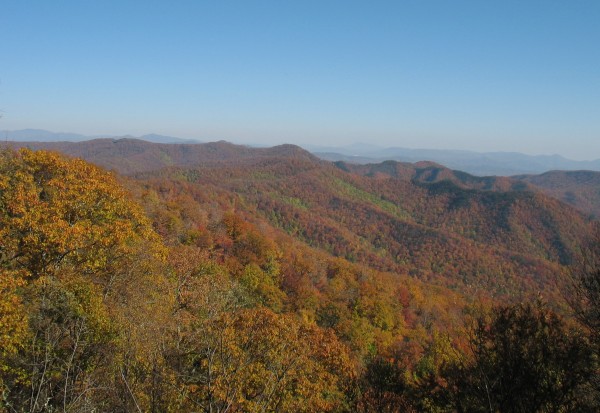
Autumn is a spectacular time of color in many areas of the Earth, and the U.S. Appalachian Mountains are no exception. From radiant reds to mustard yellow, the vibrant display of color is short-lived, earning leaf-peeping a peak priority.
What causes such brilliant displays of leaf color this time of the season, anyway? Think you already know? We thought so, too. Here are a few things we learned after some quick research. Here is what we found –
Leaf Foliage
Fall foliage is a byproduct of chemical changes when deciduous trees prepare to go dormant for winter. The difference in day length (photoperiod) triggers biochemical changes in the trees starting around June 21st, the summer solstice, or the longest day of the year when the sun begins to move south and the days become shorter. Trees gradually stop producing food to prepare for dormancy when there is less light. It has nothing to do with cooler temperatures.
A tree’s roots and branches can endure freezing temperatures, but the thin and tender leaves of a broadleaf tree – such as birch or maple – will freeze and die. Any plant tissue unable to survive the cold winter months is shed to ensure the tree’s survival.
The first step in this survival process involves a shut down of a trees’ food-making process, which causes the green chlorophyll to disappear from the leaves.

A tree leaf contains three primary color pigments: green, yellow and orange. During the warm summer months, tree leaves appear green from the presence of chlorophyll. The chlorophyll in the leaves is responsible for providing the tree with energy (food) during the growing season. Chlorophyll is the primary ingredient for the process of photosynthesis, capturing sunlight, water, and carbon dioxide and turning it into glucose or tree food — in the case of maples, pancake syrup!
The orange and yellow carotenoids are also present in the leaf cells during the summer, but the chlorophyll’s green color masks the other pigments present in the leaf. As the daylight shortens, a layer of cells grows over the water tubes in the leaves so that no more water can get to the leaf. Without water, the tree can no longer perform photosynthesis, and the leaves quickly lose their green color. The fading of green allows the leaf’s other pigments to be visible.
What causes red or purple leaves?
When cells block the tubes in the leaf’s stem to prevent water from entering the leaf, sometimes sap gets trapped inside the leaf. The sugar may cause the sap to turn red or purple, which is common with maple trees.
What causes brown leaves?
When the leaves no longer have access to water, they can’t produce food. This causes them to die. The green chlorophyll dies first, followed by yellow and orange. The leaf is now dead and brown. They become dry, fall to the ground, and crunch underneath your feet. The leaves decompose, replenish the soil with nutrients, and become part of the spongy humus layer on the forest floor. The surrounding trees and plants can now prosper during the growing season from their own waste!
Summary: Why Leaves Change Colors in the Autumn
- Leaves contain the same amount of yellow and orange pigment in the summer (when they are green) as they do in autumn (when they are yellow/orange). The green pigment (chlorophyll) dominates and masks the other colors during the summer. Orange colored leaves come from carotene and yellow from xanthophylls.
- Red color, common to maples, is from anthocyanin pigments, which occur from trapped glucose. Not all trees can make anthocyanin.
- Brown leaves are dead leaves and are caused by the waste product tannin. Organisms break down the dead matter, providing nutrition for the growing season.
- You can help replace nutrients in your yard soil by composting fallen leaves.
“Winter is an etching, spring a watercolor, summer an oil painting and autumn a mosaic of them all.” –Stanley Horowitz
Source: http://www.na.fs.fed.us/fhp/pubs/leaves/leaves.shtm